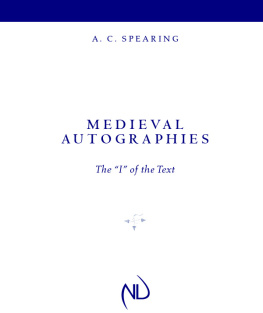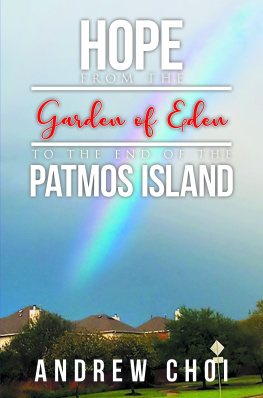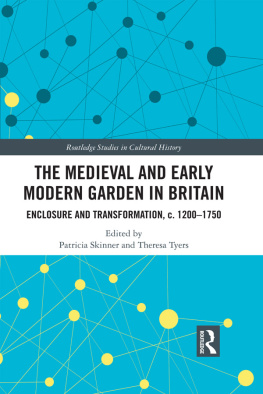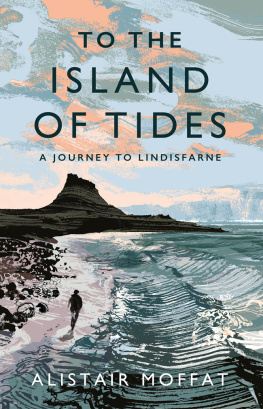Spearing A. C. - Medieval Autographies
Here you can read online Spearing A. C. - Medieval Autographies full text of the book (entire story) in english for free. Download pdf and epub, get meaning, cover and reviews about this ebook. year: 2014, publisher: University of Notre Dame Press, genre: Science. Description of the work, (preface) as well as reviews are available. Best literature library LitArk.com created for fans of good reading and offers a wide selection of genres:
Romance novel
Science fiction
Adventure
Detective
Science
History
Home and family
Prose
Art
Politics
Computer
Non-fiction
Religion
Business
Children
Humor
Choose a favorite category and find really read worthwhile books. Enjoy immersion in the world of imagination, feel the emotions of the characters or learn something new for yourself, make an fascinating discovery.
- Book:Medieval Autographies
- Author:
- Publisher:University of Notre Dame Press
- Genre:
- Year:2014
- Rating:3 / 5
- Favourites:Add to favourites
- Your mark:
- 60
- 1
- 2
- 3
- 4
- 5
Medieval Autographies: summary, description and annotation
We offer to read an annotation, description, summary or preface (depends on what the author of the book "Medieval Autographies" wrote himself). If you haven't found the necessary information about the book — write in the comments, we will try to find it.
Medieval Autographies — read online for free the complete book (whole text) full work
Below is the text of the book, divided by pages. System saving the place of the last page read, allows you to conveniently read the book "Medieval Autographies" online for free, without having to search again every time where you left off. Put a bookmark, and you can go to the page where you finished reading at any time.
Font size:
Interval:
Bookmark:
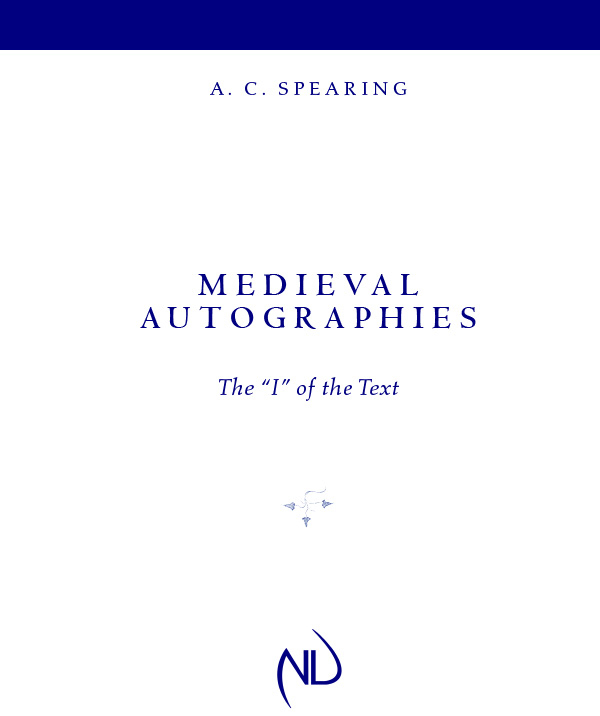
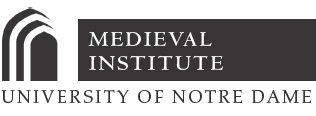
The Conway Lectures in Medieval Studies
2008
The Medieval Institute gratefully acknowledges the generosity of Robert M. Conway and his support for the lecture series and publications resulting from it.
PREVIOUS TITLES IN THIS SERIES:
Paul Strohm
Politique: Languages of Statecraft between Chaucer and Shakespeare (2005)
Ulrich Horst, O. P.
The Dominicans and the Pope: Papal Teaching Authority in the Medieval and Early Modern Thomist Tradition (2006)
Rosamond McKitterick
Perceptions of the Past in the Early Middle Ages (2006)
Jonathan Riley-Smith
Templars and Hospitallers as Professed Religious in the Holy Land (2009)
A . C . S PEARING
M EDIEVAL A UTOGRAPHIES
The I of the Text

U NIVERSITY OF N OTRE D AME P RESS
N OTRE D AME, I NDIANA
Copyright 2012 by the University of Notre Dame Press
Notre Dame, Indiana 46556
www.undpress.nd.edu
All Rights Reserved
E ISBN 978-0-268-09280-1
This eBook was converted from the original source file by a third-party vendor. Readers who notice any formatting, textual, or readability issues are encouraged to contact the publisher at
CONTENTS
This book originated as the Robert M. Conway Lectures in Medieval Studies given at the University of Notre Dame in October 2007. I was honored to be invited to give these lectures, and I am most grateful to Tom Noble, then director of the Medieval Institute at Notre Dame, to his wife, and to his colleagues for their generous hospitality during my stay there. I am also grateful to those who heard the lectures for their searching questions and valuable suggestions, which have helped to make the book less inadequate than it would otherwise be. I owe special debts of thanks to Roberta Baranowski, associate director of the Medieval Institute, for much good-natured practical help and many entertaining e-mail messages, and to Barbara Hanrahan, then director of the University of Notre Dame Press, for her warm encouragement and shrewd guidance when I was struggling to plan the book.
The tortuous process of converting and enlarging three lectures into a book that often bears little resemblance to its original form has been eased, and the book itself much improved, by the kind colleagues and friends who have read drafts and discussed problems with me. My obligations are too many to be recorded in detail, but I should like to thank Peter Baker, Cristina Cervone, Deborah McGrady, Gary Saul Morson, and especially Elizabeth Fowler. I am most grateful to Elizabeth Spearing, who stepped forward at a crucial moment, read the whole, and made invaluable suggestions for improvement. Some more specific debts are recorded in notes to the text. It goes without saying that the books faults are my responsibility alone.
Some parts of the books argument and occasional ideas and sentences have previously appeared in the following: The Poetic Subject from Chaucer to Spenser in Subjects on the Worlds Stage: Essays on British Literature of the Middle Ages and the Renaissance, ed. David G. Allen and Robert A. White (Newark: University of Delaware Press, 1995), 1337; Textual Performance: Chaucerian Prologues and the French Dit, in Text and Voice: The Rhetoric of Authority in the Middle Ages, ed. Marianne Brch (Odense: University Press of Southern Denmark, 2004), 2145; and Was Chaucer a Poet? Poetica 73 (2010): 4154. I am grateful respectively to Associated University Presses, to Professor Marianne Brch, and to Professor Toshiyuki Takamiya for permission to reuse this material here. Some material also derives from A. C. Spearing, Dream Poems, in Chaucer: Contemporary Approaches, ed. Susanna Fein and David Raybin, 15978 (University Park: Pennsylvania State University Press, 2010); copyright 2010 by the Pennsylvania State University Press; reprinted by permission of the Pennsylvania State University Press.
In quoting from medieval texts I have silently modified editorial spelling and punctuation where I thought that would aid understanding; this goes against the grain of medieval scholarship, and with good reason, but I persist in hoping that some nonspecialists might be willing to learn more about premodern literature. Further, in the hope that the book might find a few nonmedievalist readers who are interested in the theoretical issues I discussissues that I believe ought to be the concern of others besides medievalistsI have added modern translations (my own unless otherwise specified) of all medieval texts quoted in the original, except those, generally very brief, whose meaning seemed obvious.
THE TEXTUAL FIRST PERSON
In this book I attempt to bring into focus a category of medieval English writing that has not previously been recognized as such. I call it autography, and, put simply, it consists of extended, nonlyrical, fictional writings in and of the first person. A more precise sense of what this involves and why it matters will, I hope, emerge from studies of specific texts in the following chapters, but it may be helpful to begin by indicating how my recognition of this categoryperhaps better called a supergenre than simply a genrerelates to work I did in an earlier book entitled Textual Subjectivity. Its subtitle was The Encoding of Subjectivity in Medieval Narratives and Lyrics, and in it I investigated some of the linguistic and formal features by means of which subjectivity is built into texts in the two supergenres of narrative and lyric, and I tried to show how attention to these features might affect literary interpretation. Much of the argument of Textual Subjectivity was negative, illustrating how, as it seemed to me, failures of attention to the way language works in specific medieval texts had led to widespread misinterpretations. Dissatisfaction with accepted readings of major works such as Troilus and Criseyde, The Man of Laws Tale, and Pearl, and a growing conviction that they were indeed bad readingsand often perhaps worse than bad, because they seemed contemptuous of the actual achievements of great poetsled me to question the assumptions on which I came to see they were based. Underlying my argument was a distinction between the representation of subjectivity and its encoding in the written form in which all the medieval literature we know has come down to us.
To explain this as briefly as possible: An assumption of long standing is that writing is a representation of speech, with the consequence that, as one medievalist sweepingly puts it, no tale can be interpreted except as the product of a human speaker.
Reading aloud to listeners was a common practice in the Middle Ages, as in the famous scene in Chaucers Troilus and Criseyde in which Pandarus visits Criseyde in her palace,
And fond two othere ladys sete and she,
Withinne a paved parlour, and they thre
Herden a mayden reden hem the geste
Of the siege of Thebes, while hem leste. (II 8184)
[And found her and two other ladies seated in a paved parlor, and these three were listening to a maiden reading the story of the siege of Thebes to them for as long as they pleased.]
But what is being read aloud is a book, and it is important to grasp that in medieval linguistic theory it was not assumed that writing must be a representation of speech; on the contrary, as Martin Irvine and David Thomson put it,
Font size:
Interval:
Bookmark:
Similar books «Medieval Autographies»
Look at similar books to Medieval Autographies. We have selected literature similar in name and meaning in the hope of providing readers with more options to find new, interesting, not yet read works.
Discussion, reviews of the book Medieval Autographies and just readers' own opinions. Leave your comments, write what you think about the work, its meaning or the main characters. Specify what exactly you liked and what you didn't like, and why you think so.

